 DIY Tutorial: How to Strip Paint Off Wood
DIY Tutorial: How to Strip Paint Off Wood
... by Tim Snyder

☑ Using Heat Guns & Chemical StrippersStripping an old finish from furniture or trim is almost like finding buried treasure. A good stripping job can transform a yard-sale bargain or restore an antique to its original glory. There are two ways to strip wood:1. Heat Gun: A heat gun softens the finish and works best on thick, many-layered paint. 2. Paint Stripper: Chemical paint strippers partially dissolve paint, so they're favored for removing fewer layers of paint and clear finishes. Either way, you'll have to scrape the softened finish from the wood. Professional strippers often use both methods on a single job. |
☑ Tools & Materials: |
☑ Heat Gun Kit: |
|
|
▸ Paint Stripper: methylene chloride, solvent-based, DBE or NMP ▸ Paint remover wash ▸ Heat gun ▸ Molding scraper ▸ Awls and probes ▸ Fire extinguisher ▸ Rubber gloves |
▸ Refinisher ▸ Paintbrush ▸ Putty Knife ▸ Respirator ▸ Goggles ▸ Drop cloth ▸ Scrub pad ▸ Steel wool ▸ Portable fan |
|
☑ Heat Guns: An Overview:Heat guns work best on thick, built-up layers of paint. While an inexpensive heat gun will eventually soften any finish, you'll work faster with a gun that can blow air at 1,000 degrees. Hotter than that isn't better, since higher temperatures release more vapors.The thinner the paint, the less effective a heat gun will be. To lift just one or two coats, use a chemical stripper. Same goes for varnish, lacquer and shellac; heat will just make them sticky, and they could catch fire. Use a chemical stripper on window sashes, too: heat can (and will) break the glass.  Equip yourself with a putty knife and a molding scraper to remove softened finish. Don't scrape paint with sharp chisels or knives: they're liable to dig in. Your scrapers' blades may get hot, so choose tools with substantial handles to protect your (gloved) hand from the heat. You may want to keep a few scrapers handy; the blades don't work as well when they're hot, so if you can trade off, each one will be able to cool completely before you need it again. Equip yourself with a putty knife and a molding scraper to remove softened finish. Don't scrape paint with sharp chisels or knives: they're liable to dig in. Your scrapers' blades may get hot, so choose tools with substantial handles to protect your (gloved) hand from the heat. You may want to keep a few scrapers handy; the blades don't work as well when they're hot, so if you can trade off, each one will be able to cool completely before you need it again.
|
☑ Heat Guns: Step by Step: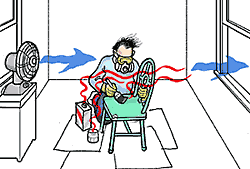 1. Put down a canvas drop cloth to catch paint peelings: newspaper catches fire too readily. 1. Put down a canvas drop cloth to catch paint peelings: newspaper catches fire too readily.
2. Hold the gun 5 inches away from the painted surface, and apply heat until the paint bubbles. Keep the gun moving. With your putty knife, scrape the softened paint away from the wood as you direct hot air over the next patch of paint. At times, you may need to bring the gun's nozzle closer to the wood, but be careful not to scorch it unless you plan to paint it again. Take care not to scratch the wood with your scraper. Remove only the finish that comes away easily. The last layer of finish is often best removed with a chemical stripper. 3. Dump the paint peelings onto your drop cloth or set up a box to scrape them into as you go. Left on the workpiece, they'll reattach themselves as they cool. When you're done, bag them and put them in the trash. |
☑ Chemical Paint Strippers: An Overview:Except for furniture refinishing compounds, stripper usually comes as a thick gel that you apply in a heavy layer. That keeps the active ingredient from evaporating too quickly. Strippers can be highly specialized, so select the right type for the job you're planning. Follow the recommendations below, and always read the label so you're sure of what it is and how it works.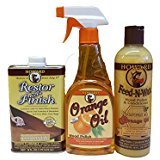 Furniture refinishers are solvents that dissolve aging shellac and lacquer. You can then remove the finish altogether using steel wool or, working more gently, just take off the cracked or dirt-impregnated top layer. Furniture refinishers are solvents that dissolve aging shellac and lacquer. You can then remove the finish altogether using steel wool or, working more gently, just take off the cracked or dirt-impregnated top layer.
|
 Methylene Chloride Strippers:
Methylene Chloride Strippers:
News Release: EPA Bans Consumer Sales of Methylene Chloride Paint Removers. EPA has taken this action because of the acute fatalities that have resulted from exposure to the chemical. Paint removal products containing methylene chloride will not be able to be sold at any retail or distribution establishments that have consumer sales, including e-commerce sales.
Solvent-Based Strippers
These work more slowly but still require protective gear and good ventilation. And, of course, they're flammable.☑ 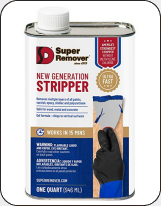 New Generation Stripper
New Generation Stripper
This revolutionary, patent pending, new stripper works similar to products containing methylene chloride, but uses only safer ingredients.
Safe for wood, metal and concrete. Brings a natural finish to your furniture. Gentle on antiques. Water cleanable.
☑  Citristrip® Paint & Varnish Stripping Gel
Citristrip® Paint & Varnish Stripping Gel
This and other relatively safe strippers use n-methyl pirrolidone (NMP) and other solvents that aren't as volatile as the traditional strippers. Nonetheless, you'll still want to work in a well-ventilated area and wear gloves and eye protection. These chemicals work slowly, so apply several coats, then cover the stripper with plastic to slow evaporation.
☑ Chemical Paint Strippers: Step by Step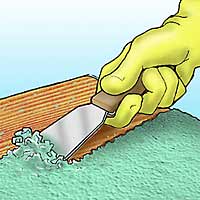 1. Prep your work area. If you're stripping inside, make sure your ventilation is adequate. Put down newspapers to catch the mess. Again, wear old clothes, long sleeves, goggles and rubber gloves. 1. Prep your work area. If you're stripping inside, make sure your ventilation is adequate. Put down newspapers to catch the mess. Again, wear old clothes, long sleeves, goggles and rubber gloves.
2. Apply the stripper. Pour some stripper into a wide-mouthed container. With a cheap or worn-out natural-bristle brush, paint it thickly on the workpiece. Brush only in one direction, and go slow to minimize splashes. If you're working on a large piece with fast stripper, do one part at a time one side of a wooden chest, for example. To improve a slow stripper's performance, cover the piece with a plastic (poly) sheet or seal it in a plastic garbage bag. 3. Wait for the bubbles, then scrape off the finish. When the finish has softened, it will form bubbles and wrinkles and pull away from the wood surface. That's when you start scraping. Apply more stripper in areas where this loosening hasn't occurred. Note: Latex paints don't always bubble; let the stripper work awhile, then test for softened paint with your scraper. Scrape flat surfaces with a putty knife and contours with a molding scraper. Use an awl or probe and a toothbrush to get into tight spaces. Use a fistful of dry wood shavings to scour complex surfaces; shavings also absorb leftover stripper. To remove finish from the crevices of lathe-turned legs, pull twine back and forth as if shining your shoes. Keep those goggles on: the gunk will fly. Don't scrape too hard where finish is reluctant to come off. You can always apply a second coat. 4. Rinse and smooth the wood. Citristrip makes a wash with a mineral spirit base that removes chemical residue. Soak a fresh scrub pad with it and wash the piece thoroughly. This stuff puts out a lot of vapor, so ensure good ventilation and use your goggles and gloves. Let the wood dry and smooth it with very fine sandpaper or steel wool before you put on the new finish. Look closely for areas that need attention: loose veneer and holes that need patching, for example. 5. Clean up the mess. While the mixture of stripper and old finish is wet, it's hazardous. Let your slime-covered newspapers dry in the open air before you bag them. The safe DBE- and NMP-based strippers take a long time to dry. Find a place where your safe-stripper-based mess can dry out without the risk of a child or pet getting into it: perhaps an open-topped cardboard box in your attic or up in the rafters of your garage. Check with your local hazardous-waste office to see if you can add the stuff to your ordinary trash. Many municipalities require that you take old paint, cans, residue, solvent and the like to a special disposal facility. |
☑
Written for students with some background in engineering, this comprehensive, highly acclaimed text does not only provide detailed instructions on how to solve hazardous waste problems but also guides students to think about ways to approach these problems.
|
🌵 Search azWoodman
 We are a participant in the Amazon.com Services LLC Associates Program, an affiliate advertising program designed to provide a means for sites to earn advertising fees by advertising and linking to Amazon.com.
We are a participant in the Amazon.com Services LLC Associates Program, an affiliate advertising program designed to provide a means for sites to earn advertising fees by advertising and linking to Amazon.com.

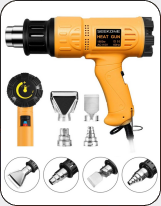

 Book: Hazardous Waste Management
Book: Hazardous Waste Management